Current research students
Our PhD, MRes and MLitt students work across four schools researching a wide array of topics. Current research students in each school are listed here.
Clyde Doyle - Towards the Omnicentre
Supervisor(s): Dr. Marcus Hanratty, Dr. Caoimhe McMahon
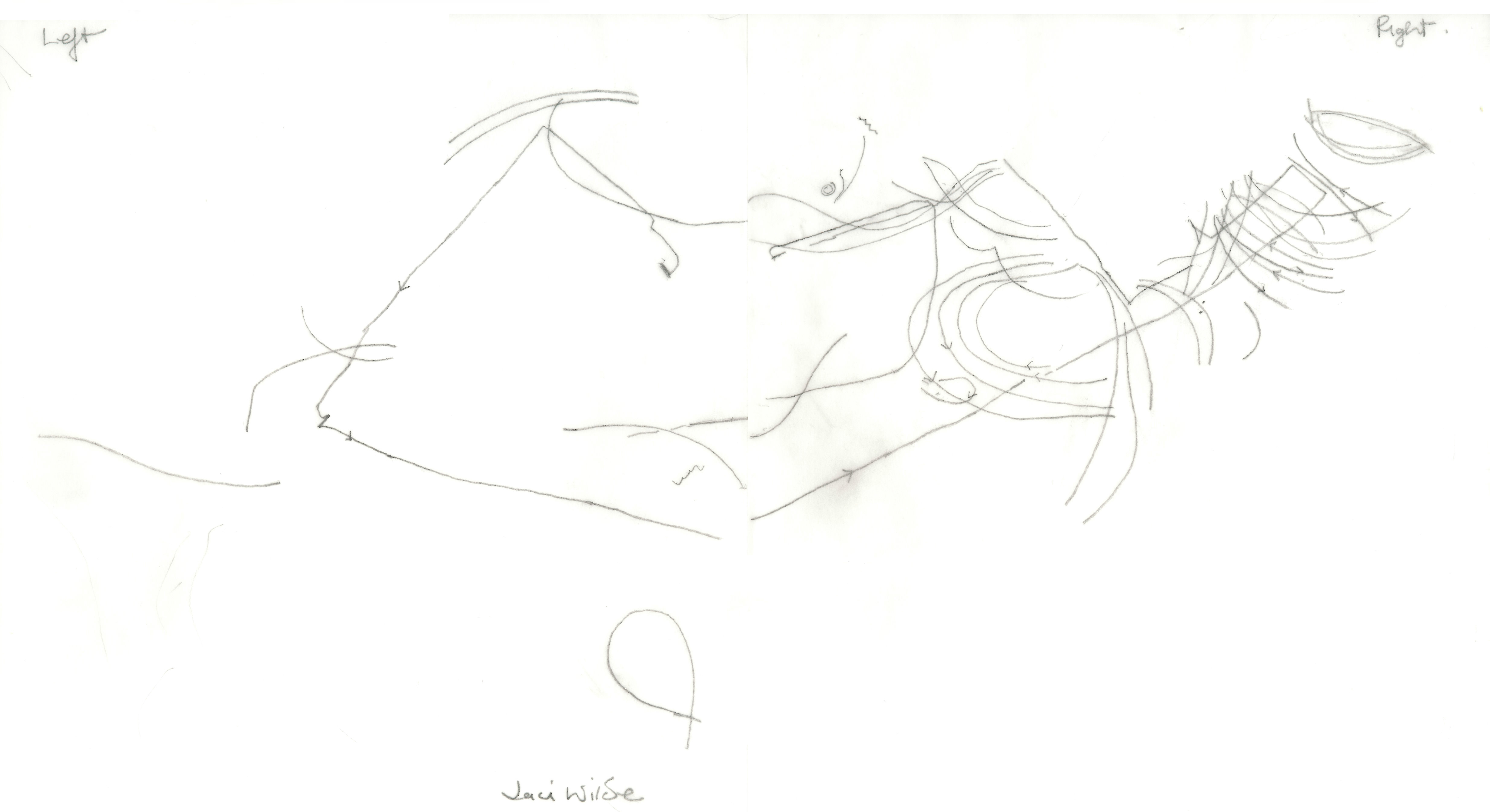
Record of bird encounters on Derry’s city walls during the Lines of Flight workshop (participant Jaci Wilde)
It has become increasingly clear that our modern human modes of living are incongruous with the natural systems that sustain us and other lifeforms on our planet. Modern design has been a major contributor to these systemic conditions of structured unsustainability, what Tony Fry calls its ‘defuturing effects’. What is required of design are more than minor adjustments to methodologies, or new design tools, but a radical shift in perception, comprehension and practice. My research-by-practice attempts to create conditions for new ways of seeing and thinking about ourselves (humans) and others (the more-than-human) with the aim of not just de-centring the human but moving towards a shared centre with the ultimate aim of facilitating ecological design practice. Using a diffractive methodology, I am currently developing experiments and experiences for design practice (experiential learning opportunities) which can be described to varying degrees as radical, relational, bio-regional, non-verbal, ontological, troubling, embodied and performative. These can be used by designers, design educators, and non-designers to listen to those more-than-human voices, challenge the unecological status quo, trouble current modes of design practice, and hopefully engender new ones.
----------
Emma Hogan Exploring the use of somatic approaches to amplify embodied, situated knowledge and inner/outer coherence in Design Education (provisional title)
Supervisor(s): Dr. Emma Creighton, Dr. Marcus Hanratty
This research investigates the role of somatic, body-centered approaches in reimagining undergraduate design education. Contemporary design challenges—rooted in social, environmental, and ethical complexities— demand pedagogies that move beyond cognitive dominance toward embodied, situated, and relational forms of knowing. Drawing on feminist, decolonial, and pluriversal theories, the study positions the body as a critical site of learning, challenging traditional paradigms that privilege intellect over embodied experience.
Through a practice-led, action research methodology, the project explores how conscious movement, sensory exercises, and creative somatic practices can foster embodied cognition, emotional regulation, and reflective creativity within Communication Design education. Research explores whether embodied engagement can enhance self-awareness, support creative breakthroughs, and nurture ethical responsiveness, in turn offering students more holistic ways of approaching design practice and tools to support the intensive nature of affect in contemporary design education.
The PhD explores how integrating somatic methods into existing educational structures requires systemic, gradual shifts in pedagogy, and challenging ingrained norms that marginalize embodied ways of knowing. The research aims to contribute to the growing field of somatic design education by proposing guiding principles for integrating body-centered practices, advocating for design curricula that value lived, embodied experience as foundational to making, thinking, and being. In doing so, it proposes an education model that equips future designers with the internal resources needed to engage responsibly with a changing world.
Avril Buttle - Cross curricular opportunities observed in the secondary school visual art classroom.
Supervisor: Dr. Isobelle Mullaney
What are the cognitive aspects of art education?
How can engagement with art processes inform human development in other areas/subjects/professions?
Can art specific methodologies and practices benefit other subjects?
Art teachers are often isolated in the Irish secondary school context and often feel neglected in terms of subject recognition and academic respect. With a curricular shift across the board that encourages students to be more self-critical and reflective of their learning, does art as a subject have anything to offer other subjects in terms of collaboration and sharing reflective critical skills that are embedded within art practice? Art students practice self-reflection daily through use of the sketchbook and engagement in the ‘art crit’ and look and respond sessions. Studies have shown that engagement with the traditional ‘art crit’ develops student resilience along side the practice of keeping a reflective learning artefact (sketchbook/notebook/annotation of progress and work). Could these practices improve the teaching and learning in other subjects? Contrastingly, could art teachers learn from other subject teachers through engaging in professional observations?
The researcher (full time visual art secondary school teacher) proposes to explore the research questions using the action research method. It will be carried out in a co-educational Irish community secondary school context. The school serves a rural catchment area in southeast Ireland and has a current enrolment figure of 461 mainstream students. The school is part of the Delivering Equality of Opportunity in Schools initiative and is a National Behaviour Support Service partner school.
___________
Fiona Byrne (MLitt) - Building sustainable education reform: Can a design-led approach to teaching and learning support highly effective and responsive teaching practices?
Supervisor: Dr. Dervil Jordan
___________
Andrea Cleary - An Investigation to Process-led Sustainable Approaches to Teaching Art in Initial Teacher Education
Supervisor: Dr. Dervil Jordan
___________
Rhian Foley - Does the NCAD ITE program effectively prepare student art teachers with the perceived attitudes, knowledge and skills needed to implement an inclusive art education in mainstream post-primary schools?
Supervisor: Dr. Isobelle Mullaney
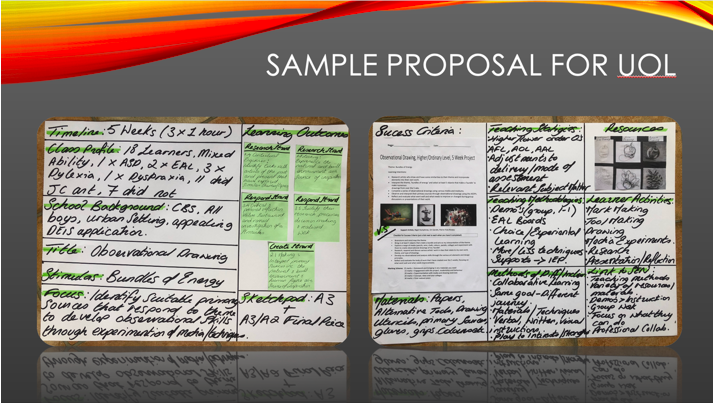
Sample proposal for UoL from the pilot SEN/inclusive education workshop in NCAD by Rhian Foley
A case study of inclusive practice preparation in the National College of Art and Design, delivering teacher education across undergraduate and postgraduate programmes. Researching and analysing the levels of positive attitudes, self-efficacy, and perceived preparedness of current students and NQAT’s, through various means. The perceived shortcomings in the current provision will be identified and used to design and implement a module to address these.
Educational inclusion has become increasingly broadened to include the catering for the needs of all children, including those who may be vulnerable, disenfranchised, from various cultures or ethnic groups, may have a special educational need and/or disability or in poverty. Current research and literature suggests that there is a definite need for investigation and exploration of this subject area now, because of the movement in both public and political opinion to integrate and/or reintegrate pupils who may fall into one or more of the categories mentioned in the above paragraph, into mainstream education in Ireland. This research aims to look at the inclusive education module taught within the professional master of education model and advise how to better prepare inclusive practitioners of post-primary visual art education. There is a need for research in this area of teacher training as the perceived lack of teacher training and preparedness is the single greatest challenge that the majority of studies have found, that prevents successful inclusive education (Mahat, 2008). The researcher, who is a full-time secondary school art teacher, will underpin the research with inclusive education theory with a pragmatic approach. This approach will consist of different research methodological tools such as, questionnaire, case study and semi-structured interviews.
Some of the research objectives include:
- What are the expectations of student art teachers from the PME/BA inclusive education module?
- What are the current reactions of student art teachers to the PME/BA inclusive education module?
- What are the expectations of initial art teachers from the teaching practicum?
- What are the reactions of initial art teachers to the teaching practicum?
- What does effective inclusion in the visual art classroom look like?
- Are students with special educational needs or students from minority groups being integrated or fully included in all aspects of art as a subject?
- Are current inclusive education policies being implemented effectively by teachers in mainstream secondary art classes?
- What are the benefits and challenges that art teachers have in the provision of an inclusive art education for their students?
- Does art, as a subject lend itself more to inclusive practice than other subjects for students?
___________
Lucy Hill - 'Posthuman material literacy' - A tool for early childhood visual art education (Irish Research Council Postgraduate Scholar)
Supervisor: Dr. Dervil Jordan
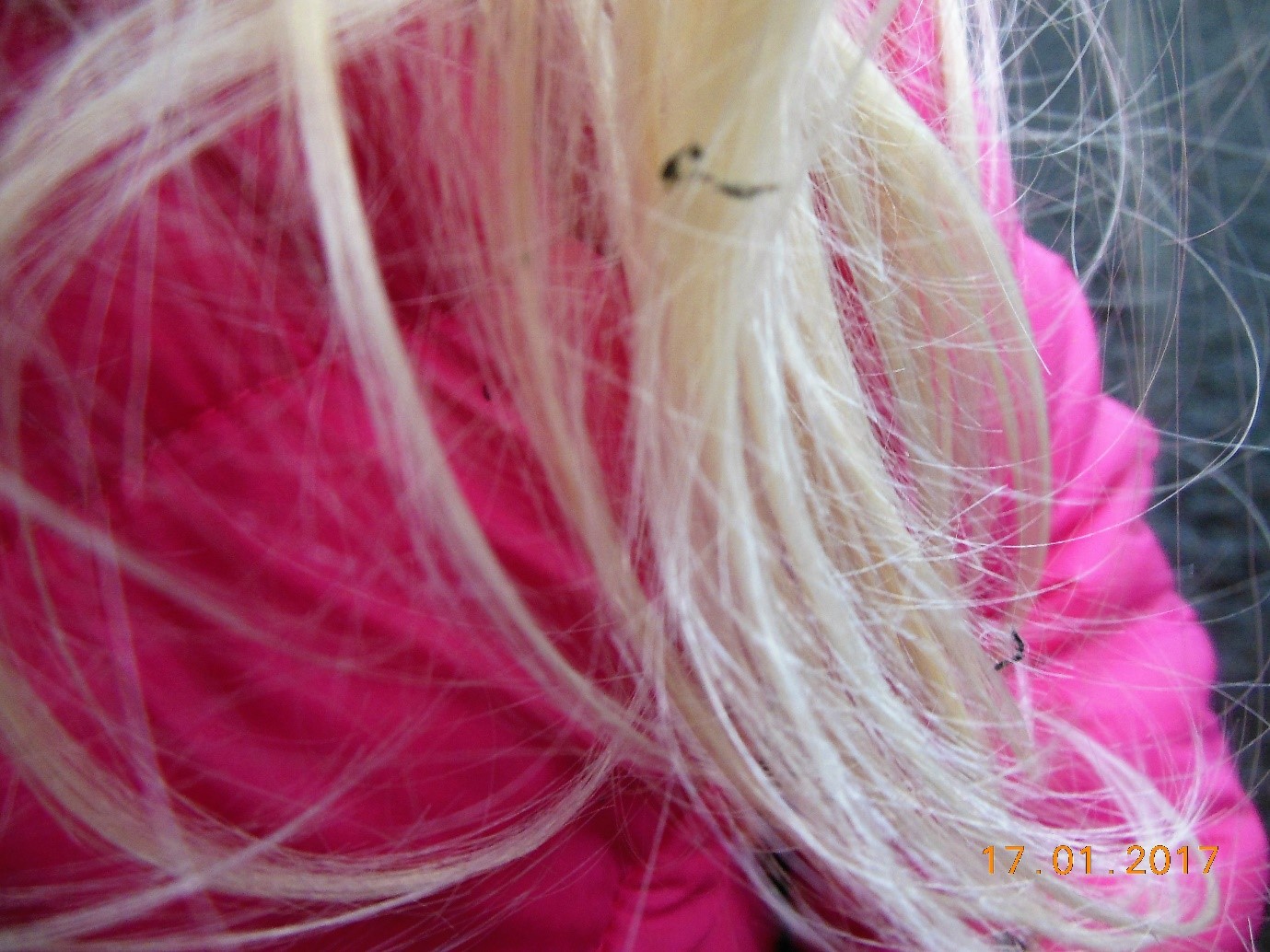
‘Fieldwork’ 2017 Lucy Hill
My project explores the intersections between Art as a ‘poetic force’ (or that which brings something new into being) and early childhood learning and care. While situated within the historically established, pedagogical importance of active learning through engagement with materials in Early Childhood Education, it also aims to acknowledges the complex ethical, ontological, epistemological and pedagogical value of young children’s everyday encounters with materials. Through Spinozist Posthuman philosophy, Feminist New Materialism and Affect theory, the research finds processes of literacy, learning and caring to be affective material assemblages, rather than anthropocentric modes of self-expression or intentional meaning making. From the starting point of the decentralised human subject in non-verbal artistic practices with materials in early childhood, the research contributes to thinking about the implications of the entangled nature of learning and caring as always materially, and thus ethically, located concerns in the context of the Anthropocene.
Awards related to this research
Irish Research Council Postgraduate Scholarship 2018
Exploring and Thinking Bursary Award 2019, Dublin City Council
Thomas Dammann Junior Memorial Award 2017
Presenter & Panel Participant, Rosi Braidotti Summer School, (Posthuman Ethics in the Anthropocene) Utrecht University 2017.
Inaugural John Coolahan Early Years Artist in Residence, The Ark Children’s Cultural Centre. Dublin 2018.
The Arts Council Travel and Training Award 2017
Three book chapters forthcoming (2020) in Routledge, Sage and Springer publications.
___________
Fiona King - What does it mean to teach and make art that is of and for our time?
Supervisor: Dr Siun O Hanrahan and Dr Audrey Bryan (DCU)
___________
Deirdre Smith - The interactive relationship between the visual art curriculum and the gallery experience at the primary school level through a blended learning approach while exploring the Froebel ethos of learning (working title)
Supervisors: Dr. Patsey Bodkin and Dr. Michael Flannery
The purpose of this action research is to analyse and question the engagement of primary school children in the gallery experience. The researcher (currently a specialist art teacher in a primary school) will focus on the visual art curriculum at primary school level paying particular attention to the draft curriculum framework and the ‘looking and responding’ stand from a teacher/learner perspective. This study will be underpinned by the Friedrich Froebel philosophy of autonomy during the creative and research process using a blended learning approach to contextualise the question, where learners can access the gallery both directly or remotely.
A theoretical bricolage will be used for presenting various insights and methodologies of this constructivist collaboration between gallery education and the visual art curriculum in primary school. It will investigate the relationship between exploratory creative processes, innate children’s artistic flow, non-discursive experiences, embodied responses, intrinsic multisensory experiential learning and visual thinking strategies.
This ethnographic study will analyse and question how primary school teachers can use such gallery education for art and other subject teaching purposes by critically examining perspectives, discourses and possible constructs of effective creative learning.
Nadia J. Armstrong Pursuing the Quantum Imaginary: A Parafiction
Supervisor(s): Dr. Tom O’Dea & Dr. Rachel O’Dwyer
This practice based PhD is a cyborg-feminist study of the forms of knowledge which operate within technoscientific research ecosystems. It considers the ways in which forms of knowledge come into being through the collective imaginaries they are informed by.
Situated in CONNECT, Taighde Éireann’s Research Centre for Future Networks and Communications, this project takes a hybrid, transdisciplinary approach, blending creative practice with critical theory from the field of science and technology studies. Sheila Jasanoff’s analytical concept of the sociotechnical imaginary refers to visions of the future moulded by technological trajectories. Via auto-ethnographic engagement with researchers working in the field of Quantum Communications, Armstrong accesses the sociotechnical imaginaries in operation in CONNECT’s quantum-based research network. Using Jasanoff’s co-productionist framework, the project is rooted in an understanding of the entangled and mutually constitutive ordering of scientific knowledge and social order. Through an interview process that draws upon technopaganism, a movement that binds esoteric practices to the digital means, Armstrong taps into her research subjects’ visions and sensibilities towards the world of quantum physics.
The practice based aspect of this PhD harnesses para-fictioning, world-building and speculative fiction to build a hybrid multimedia installation that pursues the quantum imaginary. Parafictioning is a process through which fact and fiction are set against each other, their boundaries blurred, both foregrounded as knowledge. This project reinstates othered forms of knowledge that classically operate outside of the technoscientific paradigm; forms of knowledge that rely on instinct, intuition, feeling, belief, imagination and a sense of immanence.
CONNECT is Research Ireland’s Centre for Future Networks and Communications
Leila Anglade - Documenting and representing the sensory and the relational through transcreation (provisional title)
Supervisors: Dr. Francis Halsall and Dr. Sarah Pierce
My practice-based PhD has drawn on what can be inferred from core differences between a neurodiverse approach to embodiment and the neurotypical approach to senses, with a view to outline the existence of sensory politics in our societies. I aim at expressing and translating what it means to be an autistic artist and researcher and how it affects or translates into my meaning making process.
My research so far has focused on the interaction between autism, visuality, the senses and politics. I am interested in evaluating the possibility of an ontology of autism based on differences in the embodied sensory experiences of autistic individuals. Through practice-based research, I hope to document or represent the sensory and the relational that may occur in an autistic-led art practice. I have been led by a Deleuzian rhizomatic approach focusing on multiplicity, relationality and assemblage. This approach is consistent with the way I approach the world and it has allowed me to draw from very diverse fields of knowledge (such as philosophy, critical theory, translation studies, visual culture, psychology, languages, law, sociology, neurology and biology) and many artistic practices (fine arts, 3D works, sound work, writing and performance). I think the claim to originality of my research, if any, lies in this multiplicity of approaches.
My research also draws on observations, interventions and knowledge gained through an art class I have been facilitating for the last number of years and which has given me an opportunity to situate my enquiries and research findings within the context of being an autistic artist who also operates as an art facilitator for a group of autistic and/or disabled adults. The class includes 10 to 12 participants, ranging in age from 18 to 75 years of age. Some participants have been in the class for years, others come and go. A number of participants are non-speakers. The class also involves volunteers who are usually neurotypicals as well as carers, parents, social workers and administrators who are also mostly neurotypical.
Recently, I have been working on the concept of “transcreation” as a methodology for my research projects. Transcreation is a process which involves not only translation, but also cultural adaptation and recreation or creative reinterpretation. Transcreation is not a fixed technique, it has no unique definition. It differs from translation as it emphasizes the re-creation of the original communication.
Transcreation is also an appropriate methodology for intersemiotic translation between different sensory forms of communication and representations. It gives space and allows for the gap/différance which is present in inter-semiotic translation. A transcreation methodology also allows to document and represent a form of aesthetics found in different approaches to the relational and the sensory.
_________
Fiona Kelly - Fallowness: the importance of being still
Supervisors: Dr. Declan Long, Catriona Leahy
Fallowness: the importance of being still investigates how to reinstate a space of stillness, and to valorise the potential that comes with strategic dormancy within artistic practice. Fallowness is a word borne in agriculture and seeped in humanistic control. In agrarian practices, fallowing was a controlled action where an area of cultivated land was left unseeded for one or more growing seasons; unearthed, tilled and left idle. What may have appeared as stagnation, was a much-needed period of rejuvenation, rest, germination, growth, space and time. Fallowness is a hinge between action and inaction. Stillness, latency and invisible labour. An action to reinstate a space of stillness, and of valorising the potential that comes with stillness. A necessary theorem and action for the now.
My research encompasses interdisciplinary practical and theoretical research rooted within the idiosyncratic site of the Spilt Hills Esker, Co. Westmeath. Methodologies encompass a synthesis of knowledge generated by intensive material research alongside dialogic collaborations with material innovators, geologists and mineral engineers. Artistic practice embodies and drives the research; the final thesis will be an entwining of praxis, reflection and research. New knowledge will be site specific and generated through material engagement, walking, interviews, object and exhibition making, public engagement and writing.
Fiona Kelly is a visual artist who lectures in Fine Art & Contemporary Applied Art at the MTU Sharman Crawford campus, Cork.
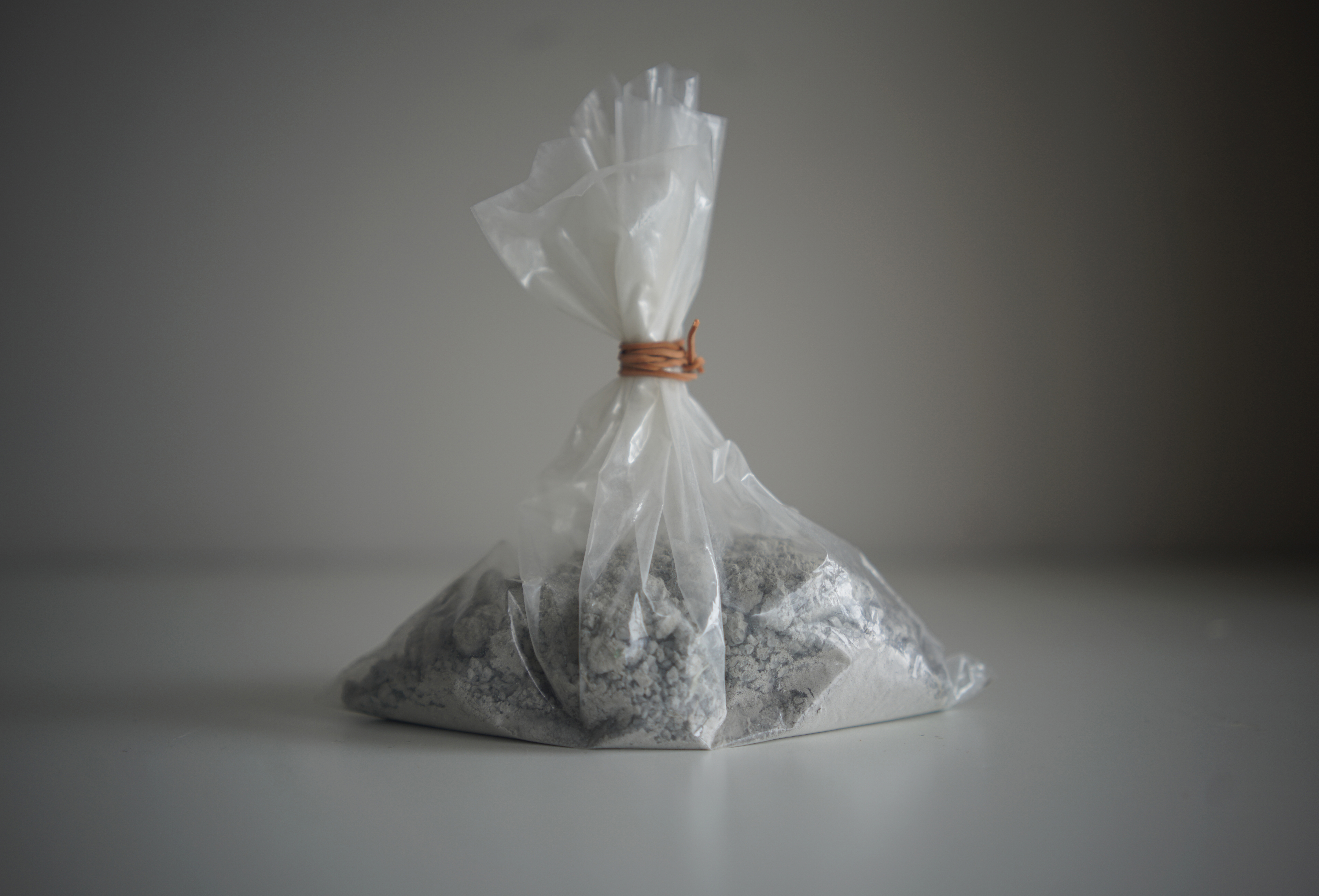
Image: Dust; for a Passive House
_________
Suzanne Freeman - Reading Materials. A practice-based-research investigation into interpreting the artefacts of James Joyce’s Ulysses for exhibition (joint registration with UCD) Supervisors: Dr Lisa Godson, Dr Emily Mark-FitzGerald (UCD)
_________
Henry Martin - American women art dealers: Establishing movements and markets for modern art between 1920-1950
Supervisors: Dr. Francis Halsall, David Crowley
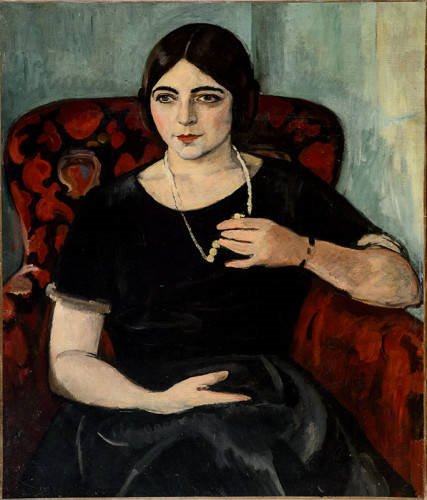
Portrait of Edith Gregor Halpert by Samuel Halpert, 1928, oil on canvas, Palmer Museum of Art
My research examines the way women dealers promoted modern art in America and the impact they had on the careers of artists and the development of artistic movements and communities. This interest was first established when I researched the dealer Betty Parsons for my biography Agnes Martin: Pioneer, Painter, Icon and expanded in my MRes dissertation Beatrice Judd Ryan: creating a modern art market in San Francisco 1925–1957. Nominated dealers for my PhD research include Marie Sterner and the Marie Sterner Gallery, Katherine S. Dreier and the Société Anonyme, Beatrice Judd Ryan and the Galerie Beaux Arts and Edith Gregor Halpert and the Downtown Gallery. One aim of this research is to explore how these dealers formed a bridge between two generations of art patrons: the Gilded Age collector (e.g. Isabella Stewart Gardner) and Depression Era museum founder (e.g. Gertrude Vanderbilt Whitney). Another aim is to examine the evolution of professionalism in American art; and the role of gender therein; particularly the relationship between gender and the avant-garde.
_________
Hugh McCabe - Algorithmic Imaging Systems
Supervisors: Dr Francis Halsall, Dr Rachel O’Dwyer
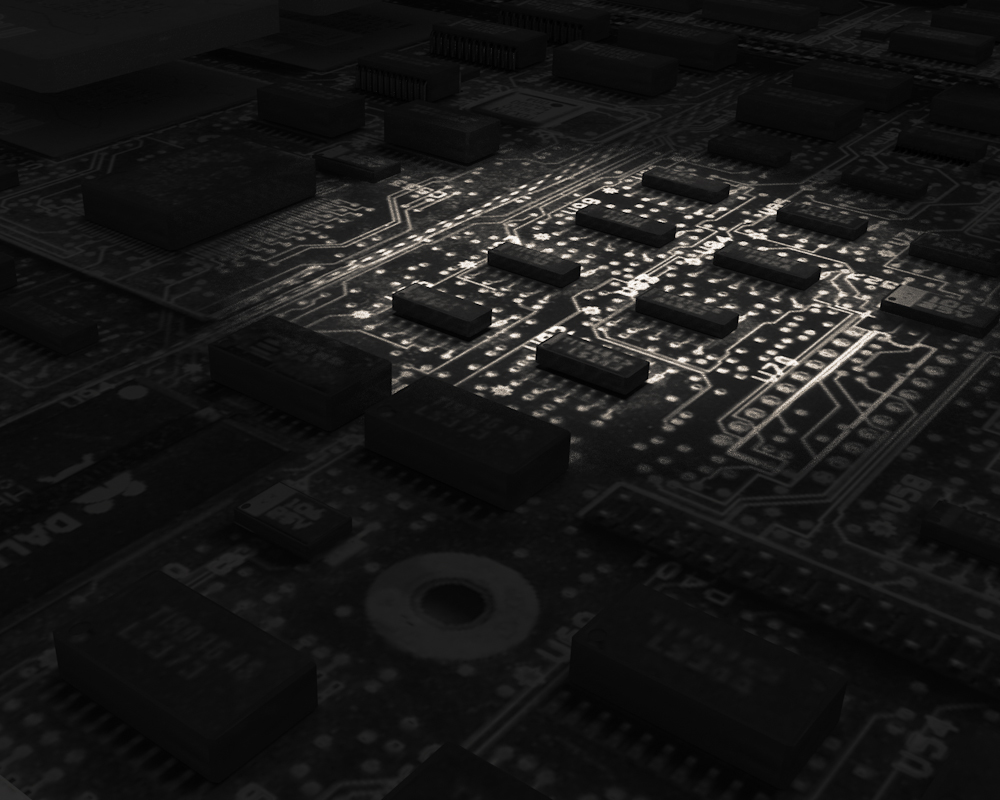
Still from Lost State, Hugh McCabe and Suzanne Walsh, 2017.
This thesis explores the early history of algorithmic imaging by focusing on the case of Frank Rosenblatt’s Mark 1 Perceptron developed at the Cornell Aeronautical Laboratory (CAL) in the late 1950s. The story of the Perceptron as a contentious moment in the history of Artificial Intelligence (AI) is well known but less well studied is the specifics of the machine itself and the circumstances of its development. I conduct a materialist media-archaeological analysis of the Mark 1 that complicates accounts of the algorithm as abstract computation, and situates Rosenblatt’s machine not just as a precursor of neural-network based machine vision but also of digital and computational photography. By drawing upon Simondon’s theory of technical evolution, I then identify key technical elements and tendencies of the Mark 1 which, I argue, are central to both machine vision itself and a broader trajectory of algorithmic imaging systems. I find these to be centred on the discretisation of the image that is necessary in order to be amenable to algorithmic manipulation and that this inevitably leads to the processes of quantification, segmentation and classification that are still evident in contemporary algorithmic imaging systems. While there have been important studies identifying the algorithm as central to contemporary imaging, there remains a need to produce a media historical account that traces this incursion of the algorithm into the terrain of the image with the aim of probing the common characteristics of the systems that arise as a result. To do this I connect the case of the Perceptron to other significant moments in the history of algorithmic imaging - including the invention of image processing at the National Bureau of Standards (NBS) in 1955 and the formulation of the rendering equation to unify disparate approaches to computer graphics in 1986 – in order to show how the discretization of the image that is demanded by the algorithm manifests itself across multiple modalities of the algorithmic imaging system. Bridging media studies, philosophy of technology, visual culture and the history of computation, this thesis contributes to a growing body of interdisciplinary work that seeks to expand critical understandings of the contemporary technical image.
_________
Bláithín Mac Donnell - Reverberations. Expanding liveness through performance, narrative and voice
Supervisors: Dr. Rachel O Dwyer, Dr. Declan Long
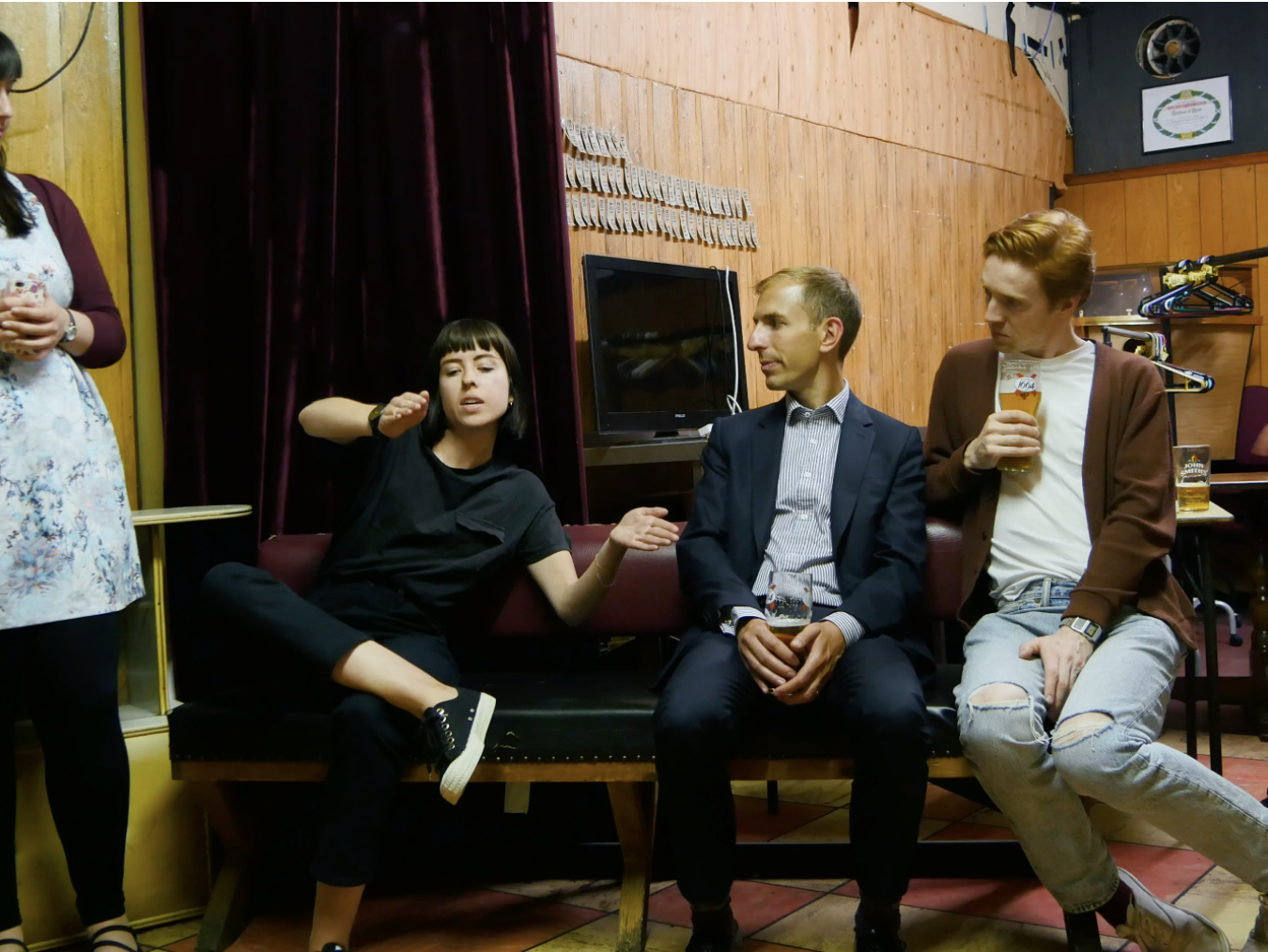
'they generally don't like to be alone' live performance for Love Sick, Laugh Magazine Live, Bethnal Green Working Men's Club, London, 2018 Bláithín Mac Donnell
Central to this practice based thesis is a live voice. Relative to my practice, this voice refers to spoken monologues which originate from texts of which I am the author and are performed within the framework of a situation or structure that I have constructed. Through narrative discourse, performative gestures and spatio-temporal situations the reader is placed as an active participant in the text reflective of the performance practice. The writing blurs the parameters of the thesis by straddling the boundaries of academic text and narrative fiction. The research is framed within the intersection of the autobiographical experiences of the artist and the academic through spontaneous dialogues and performed monologues.
Liveness continues to be understood not only through its spatio-temporal qualities but through its dichotomy. Is it live because it happened, is it live because I am told it is or is it live because of my experience of it? Understanding performance documentation as a tool to point us toward the experience of the live, the scaffolding for this thesis has been built around Philip Auslander's document as doing, Claire Bishop’s as multi-directional and Christopher Bedford’s viral. This thesis considers liveness as a reverberation, through multi-layered and multi-faceted spectatorship we can activate and re-engage with the live. The performed voice echoes beyond the space in which the story was told.
_________
Seamus Nolan - Where Things Go
NCAD School of Visual Culture + UCD Art History
IRC Enterprise Partner: IMMA
Supervisors: Dr Lisa Godson (NCAD) and Dr Róisín Kennedy (UCD)
Where Things Go is a practice based doctoral study that explores the interconnected themes of location, materiality, and mobility through creative participatory practice with Irish Traveller communities. It focuses on how nomadic materiality and geopolitical ontologies relate to Traveller arts participation. The central enquiry examines how communities might maintain cultural practices and conceptual arrangements that both contest historic appropriations and advocate for participant centred and collaborative cultural practices.
As Ireland’s largest indigenous ethnic minority, Irish Traveller cultural practices and material heritage have long been underrepresented or misrepresented in cultural institutions. Social and institutional barriers have compounded this marginalisation, limiting access and participation within the arts. The central aim of Where Things Go is to explore how socially engaged, collaborative, and participatory processes—through reflective and critical engagement—can support the cultural enfranchisement of Traveller communities. Structured around a series of six collaborative participatory projects with Irish Traveller communities over four years resulting in a series of public exhibitions, this practice-based research uses methods of collaborative engagement and production to work with aspects of Traveller history and cultural expression.
The projects are organised in terms of generating culturally situated collections of material through collaborative development (‘Where’), working with existing art collections (‘Things’), and integrating Traveller-led collections in mainstream visual art frameworks (‘Go’). A significant number of the projects involve forms of collection and curation of material and material processes both within and external to Traveller communities and organisations. This research explores how material and networks of circulation across ethnic and cultural boundaries operate while maintaining self-determinant narratives and forms for Traveller participants. Siting examples in galleries and off-site locations the work fosters the integration of Traveller-led collections into established museum and archival infrastructures.
Ultimately, this research expands upon a process and body of knowledge which generates new methodologies towards active and embodied representation within the museum.
_________
Matt Packer - Internationalisation and exhibitions of contemporary visual art in Ireland during the Celtic Tiger
Supervisors: Dr Declan Long and David Crowley
_________
Donna Rose - Collecting, Interpreting, and Mediating the Sensitive Heritage of Ireland’s Religious Social Institutions at the National Museum of Ireland
NCAD School of Visual Culture/ UCD School of Architecture, Planning, and Environmental Policy/ National Museum of Ireland
Supervisors: Dr Lisa Godson & Professor Hugh Campbell (UCD)
This doctoral project researches the physical remains of Irish religious institutions, including Magdalene Laundries, Mother and Baby Institutions, Industrial Schools, and Reformatory Schools, considering their changing meanings as objects of labour and containment to a highly disputed material realm of sensitive heritage.
Close interpretation of the remaining material culture is informed by reflective practice at the National Museum of Ireland through assisting in developing an institutional collection and its mediation with Survivors and other stakeholders. This research also explores analogous case studies, including the development of former Residential School sites in Canada and the evolving circumstances of the Sean McDermott Street Laundry in Dublin, Ireland. The former laundry has been confirmed as the location of a multi-purpose National Centre of Research and Remembrance, which will include social housing, an archive, a community centre, and an interpretive space operated by the National Museum of Ireland.
Drawing from architectural, museological, and sensitive heritage practice, collaboration with survivors and affected people, oral histories, and theories of material culture, this project ultimately advocates for an ethical framework to refer to when interpreting, mediating, and charting a course for collections, artefacts, and buildings that have a traumatic past, particularly relating to the histories of institutional abuse in Ireland.
_________
Maeve Sookram - Irish Identity through the Home: The Suburban Mid-Century Transformation
Supervisors: David Crowley, Dr. Lisa Godson
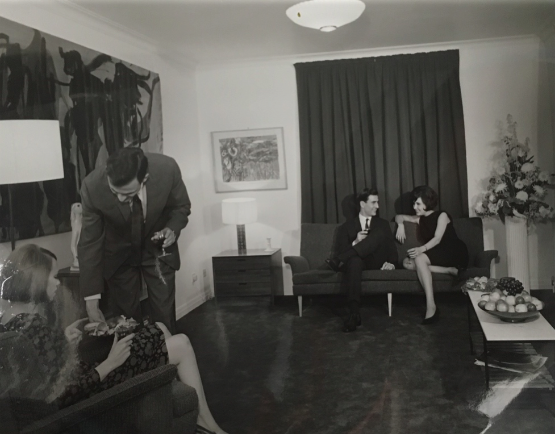
Sales promotion brochure for housing at Dundrum Heights, Dublin. Image courtesy of Wates Limited(UK).
This thesis contributes to our understanding of the material culture and social change which evolved in suburban Dublin homes from 1955-1975. It explores how contemporary affordable media influenced women in the decoration, design and management of their new privately-owned suburban mid-century homes. It systematically studies the shift from rural to urban living looking at public and private space, boundaries and mediates through new lifestyle options and choices available to the housewife.
As part of this thesis, oral history gives new understanding of everyday life and the challenges and opportunities that faced the family adjusting to and embracing modernity.
The focus of this research includes:
-
Housing estate layouts, house design and decoration
-
Impact of affordable media on the role of housewife
-
Family engagement with new social space and new technologies
_________
Jennie Taylor - Applications of feminist worldings, diffractive methodologies and entanglements through fictional narratives of art objects created during 1952-1960 New York City
Supervisors: Dr. Francis Halsall, Dr. Declan Long
Drawing from feminist philosopher of science Karen Barad, my practice-based PhD adopts a diffractive methodology through forensic archival research of physical properties of selected artworks from post-war New York art history, particularly work made and exhibited in Downtown, Manhattan between 1952-1960. Particles in artworks’ material are treated as characters to construct written narratives. The content of each narrative is informed by the behaviour of each particle and the position of the selected artwork within art history. This work presents fictional versions of existing histories rooted in verifiable information from artworks’ material. I address Barad’s concerns by practicing an ethico-onto-epistemological approach to art history in which intra-actions of phenomena occur in fictional narratives. Fiction is used as an instrument to world the contents of art objects into entangled worldings. In my research, a thick past is present through the existence of art objects and their archives; artworks are presented as agents of history to a point of exaggeration in order to create and take up space in historical narratives.
_________
Wei Yifeng - On the Aesthetics of Opacity in Decolonial Art Practice (Working Title)
Supervisors: Dr. Francis Halsall, Dr. Rachel O'Dwyer
Today’s technologies, such as AI, are undoubtedly a double-edged sword, simultaneously liberating us from the limitations of human capacity and exerting control over our daily lives through pervasive surveillance systems. Scholars like Nick Couldry have called for understanding technology within a colonial framework due to the parallels between colonial exploitation and the extraction of data in the digital age. Consequently, resisting the harms of contemporary technology necessitates learning from historical forms of resistance in colonial contexts.
This study examines postcolonial scholar Édouard Glissant’s concept of opacity, arguing that the colonial pursuit of transparency—historically imposed upon “The Other”—persists in the AI era. It further contends that opacity, as manifested in decolonial artistic practices, holds potential as a methodological strategy for resisting technological governance by embracing invisibility and ambiguity.
To explore this, the research dissects the broad notion of colonialism into three specific contexts where transparency has been systematically enforced: identity politics in the aftermath of globalization, data colonialism, and space exploration. It then seeks possible avenues of resistance by introducing an aesthetics of opacity drawn from decolonial art practices. Additionally, this study considers the practical application of such aesthetics, examining how it can be implemented within gallery spaces through exhibition case studies and the author’s own curatorial practice.
Last, this research emphasizes that the aesthetics of opacity originates from decolonial efforts and offers a critical response to today’s technological crises. By reintroducing opacity into daily life, it affirms the fundamental right to remain unseen and untracked in an era increasingly defined by surveillance and datafication.
_________
